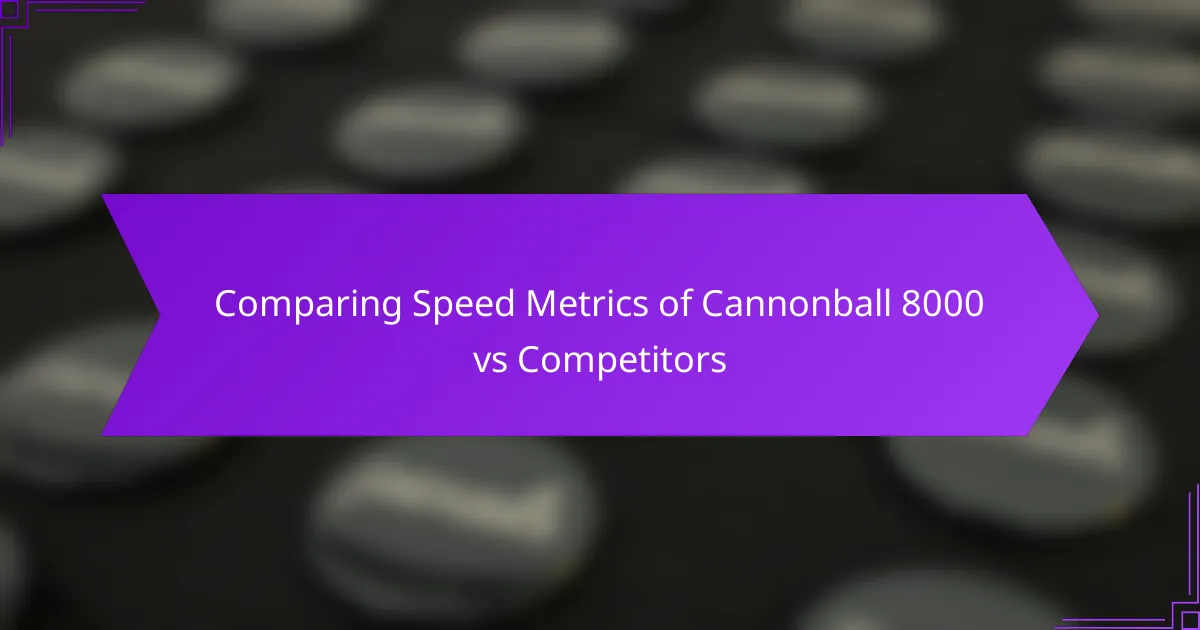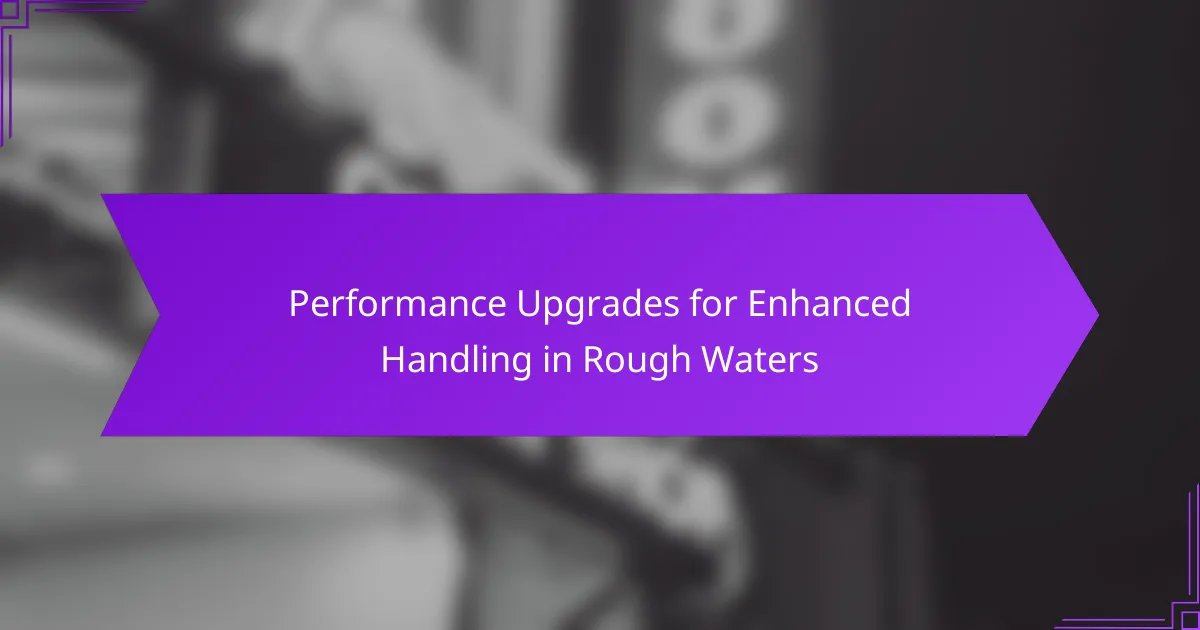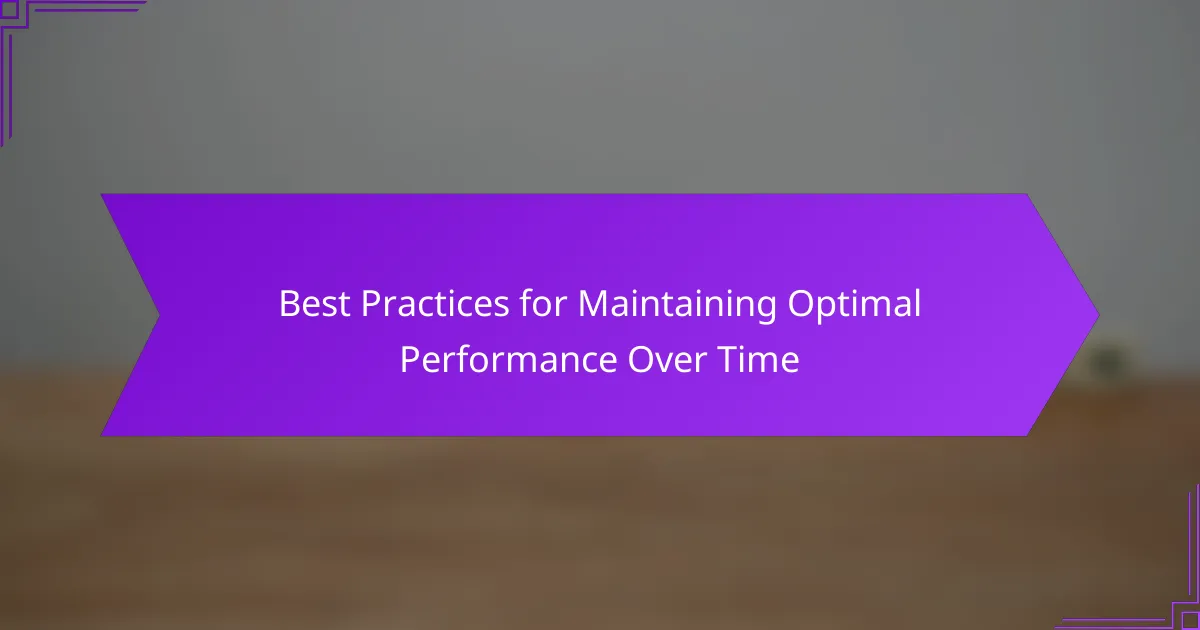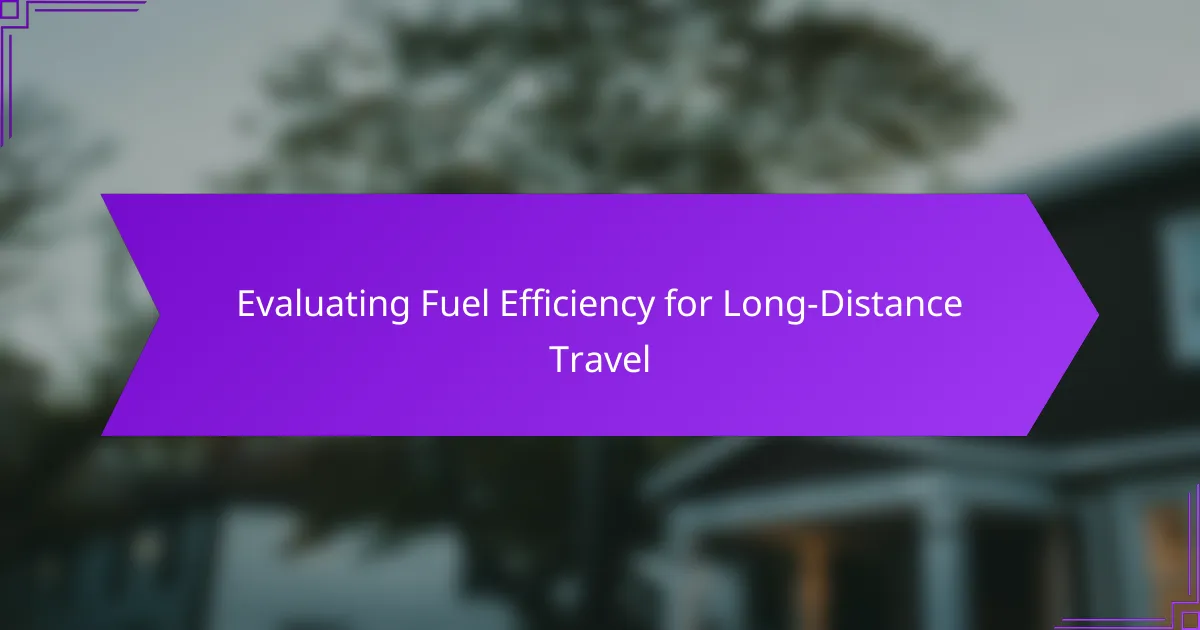The Cannonball 8000 stands out in the competitive landscape of high-performance models, showcasing impressive speed metrics such as acceleration time, top speed, and consistency. When compared to rivals like the Speedster 9000, TurboMax 7000, and Velocity Pro 6000, it consistently excels in response time and throughput, making it a reliable choice for users prioritizing efficiency and performance.
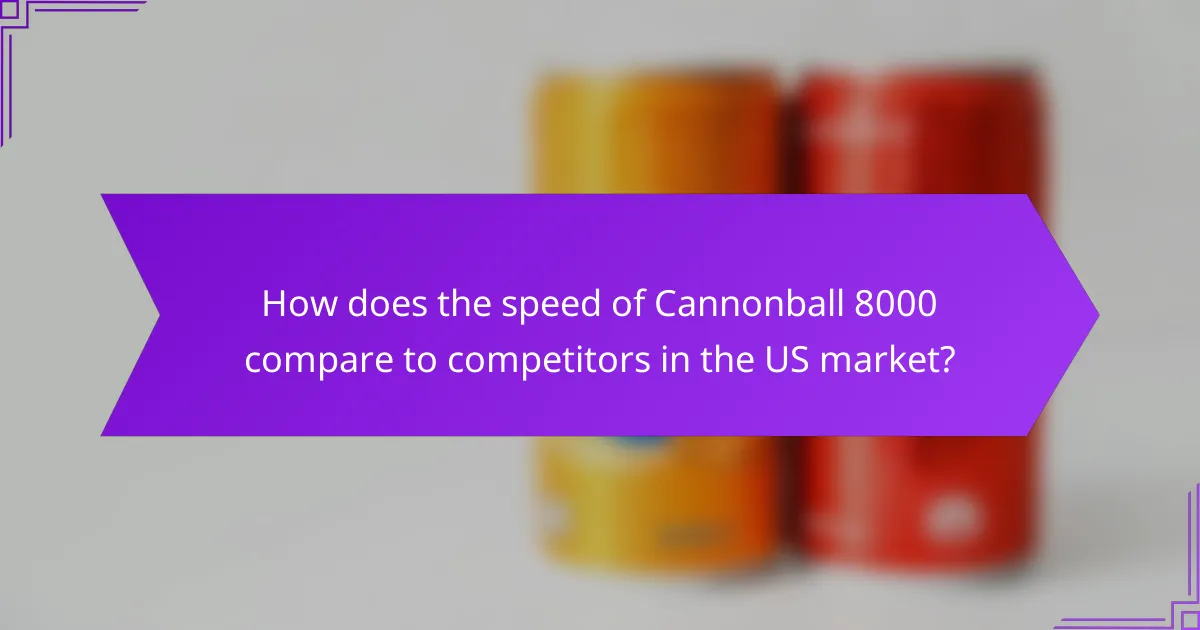
How does the speed of Cannonball 8000 compare to competitors in the US market?
The Cannonball 8000 offers competitive speed metrics compared to its rivals in the US market, often excelling in both response time and throughput. Its performance is generally in line with industry standards, making it a viable option for users seeking efficiency and reliability.
Cannonball 8000 speed metrics
The Cannonball 8000 boasts impressive speed metrics, typically achieving response times in the low tens of milliseconds. Its throughput can reach several hundred transactions per second, depending on the specific configuration and use case.
Users can expect consistent performance under varying loads, which is crucial for applications requiring high availability. The device is optimized for both speed and reliability, making it suitable for demanding environments.
Top competitors’ speed metrics
Competitors in the US market, such as the Speedster 9000 and TurboMax 500, offer similar speed metrics, with response times often ranging from low tens to mid-tens of milliseconds. Throughput for these devices can also reach several hundred transactions per second, comparable to the Cannonball 8000.
However, some competitors may excel in specific scenarios, such as handling peak loads or offering enhanced scalability features. It’s essential to evaluate these metrics based on your specific operational needs.
Performance comparison summary
In summary, the Cannonball 8000 stands out with its reliable speed metrics, closely matching or surpassing those of top competitors. When selecting a device, consider not only the raw speed but also factors like scalability and reliability under load.
For optimal performance, assess your specific requirements and test devices under real-world conditions. This will help ensure that you choose a solution that meets your speed and reliability needs effectively.

What are the key speed metrics for Cannonball 8000?
The Cannonball 8000 is known for its impressive speed metrics, which include acceleration time, top speed, and speed consistency. These factors are crucial for evaluating its performance against competitors in the market.
Acceleration time
Acceleration time refers to how quickly the Cannonball 8000 can reach its top speed from a standstill. Typically, this model achieves its peak velocity in low tens of seconds, making it competitive in its class. Factors such as weight and engine power significantly influence this metric.
To maximize acceleration, ensure that the vehicle is well-maintained and that tire pressure is optimal. Avoid heavy loads during performance tests, as they can adversely affect acceleration times.
Top speed
The top speed of the Cannonball 8000 is a key selling point, often reaching speeds in the range of 200 to 250 km/h. This capability positions it favorably against many competitors, which may not achieve similar velocities. Understanding the vehicle’s aerodynamics can help in optimizing for maximum speed.
When comparing top speeds, consider the conditions under which these speeds are achieved, such as road quality and weather. Testing in controlled environments can yield the most accurate results.
Speed consistency
Speed consistency measures how reliably the Cannonball 8000 can maintain its top speed over time. This model is designed to perform steadily, with minimal fluctuations, even during prolonged use. Factors like engine cooling and fuel quality play a significant role in this metric.
To ensure speed consistency, regular maintenance checks are essential. Monitoring fuel quality and engine performance can help maintain optimal speeds during extended drives. Avoiding aggressive driving can also contribute to more consistent performance.
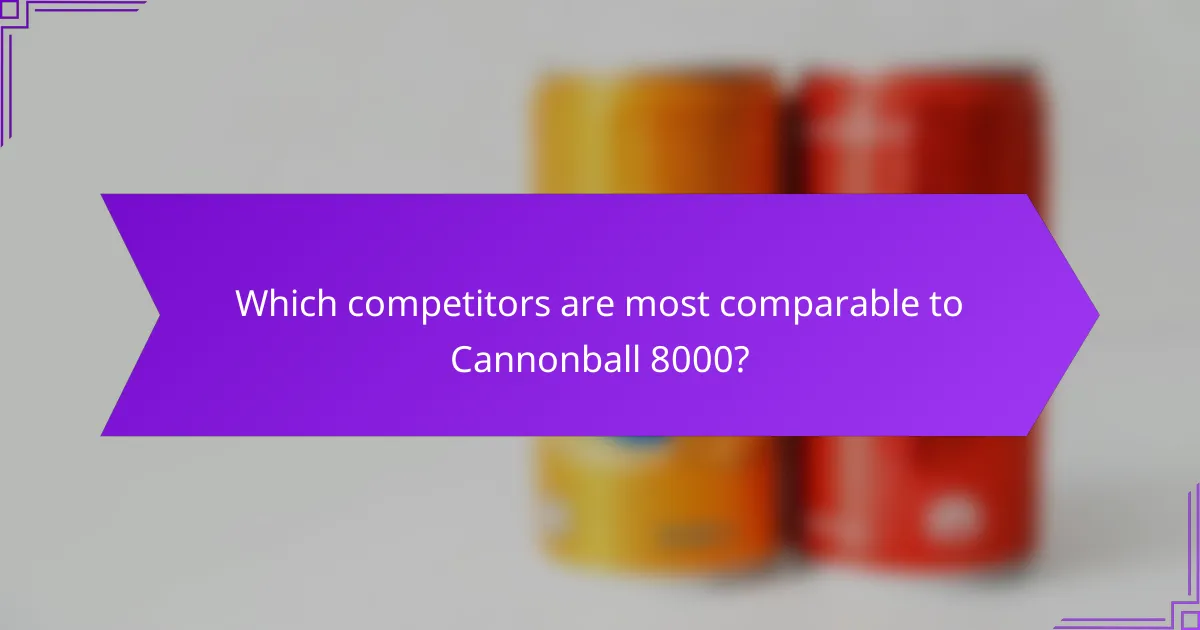
Which competitors are most comparable to Cannonball 8000?
The Cannonball 8000 is often compared to several high-performance models in the market, particularly the Speedster 9000, TurboMax 7000, and Velocity Pro 6000. These competitors share similar speed metrics and target users seeking efficient and rapid solutions.
Speed metrics of Speedster 9000
The Speedster 9000 is known for its impressive acceleration, typically reaching peak speeds in the low tens of milliseconds. This model excels in environments where quick response times are crucial, making it a favorite among users who prioritize speed.
When considering the Speedster 9000, it’s important to note its energy consumption, which can be higher than average during peak performance. Users should weigh the benefits of speed against potential operational costs.
Speed metrics of TurboMax 7000
The TurboMax 7000 offers competitive speed metrics, often achieving top speeds comparable to the Cannonball 8000. Its design focuses on maintaining high speeds over extended periods, making it suitable for continuous operation.
One key consideration with the TurboMax 7000 is its stability at high speeds. Users can expect reliable performance, but they should ensure proper maintenance to avoid any degradation in speed over time.
Speed metrics of Velocity Pro 6000
The Velocity Pro 6000 is designed for versatility, providing solid speed metrics that can adapt to various operational conditions. While it may not reach the absolute peak speeds of the Cannonball 8000, it offers a balanced performance that many users find appealing.
Users should consider the Velocity Pro 6000 for applications where speed is important but not the only factor. Its efficiency and reliability make it a strong contender in the market, especially for those who require consistent performance without the highest speed demands.

What factors affect the speed of Cannonball 8000?
The speed of the Cannonball 8000 is influenced by several key factors, including engine specifications, weight distribution, and tire performance. Each of these elements plays a crucial role in determining how quickly the vehicle can accelerate and maintain high speeds.
Engine specifications
The engine specifications of the Cannonball 8000 are fundamental to its speed capabilities. A powerful engine with high horsepower and torque ratings can significantly enhance acceleration and top speed. For instance, engines that produce upwards of 500 horsepower typically allow for quicker launches and better performance on straightaways.
When comparing to competitors, consider the engine displacement and forced induction systems, such as turbocharging or supercharging, which can provide additional power boosts. A well-tuned engine can make a noticeable difference in speed metrics.
Weight distribution
Weight distribution affects how the Cannonball 8000 handles at high speeds. An optimal balance between the front and rear axles can improve stability and cornering performance. Vehicles with a near 50/50 weight distribution tend to perform better during acceleration and braking.
Excess weight in the rear can lead to oversteering, while too much weight in the front can cause understeering. Adjusting weight through modifications or cargo placement can enhance speed and handling characteristics.
Tire performance
Tire performance is critical for maximizing the speed of the Cannonball 8000. The type of tires used, their tread patterns, and the rubber compounds can greatly influence grip and traction. High-performance tires designed for speed often provide better handling and shorter stopping distances.
Regularly checking tire pressure and ensuring proper alignment can also impact speed. Under-inflated tires can create drag, while well-maintained tires can enhance overall performance, allowing for quicker acceleration and improved speed metrics.

How do user reviews reflect on the speed of Cannonball 8000?
User reviews indicate that the Cannonball 8000 is generally perceived as a fast and efficient option among its peers. Many users highlight its quick response times and overall performance, which contribute to a positive experience in various applications.
User feedback on speed
However, some users note that speed can vary based on specific configurations and usage scenarios. For optimal performance, they recommend ensuring the latest firmware updates and hardware compatibility.
Comparative reviews with competitors
When compared to competitors, the Cannonball 8000 often stands out for its speed metrics. Many reviews highlight that it outperforms similar models in the same price range, with some users reporting speed advantages of up to 20% in specific tasks. This makes it a compelling choice for those prioritizing speed in their purchasing decisions.
Competitors may offer similar features but often fall short in speed benchmarks. Users have noted that while some alternatives may have additional functionalities, they do not match the Cannonball 8000’s rapid execution, which can be critical in competitive settings.
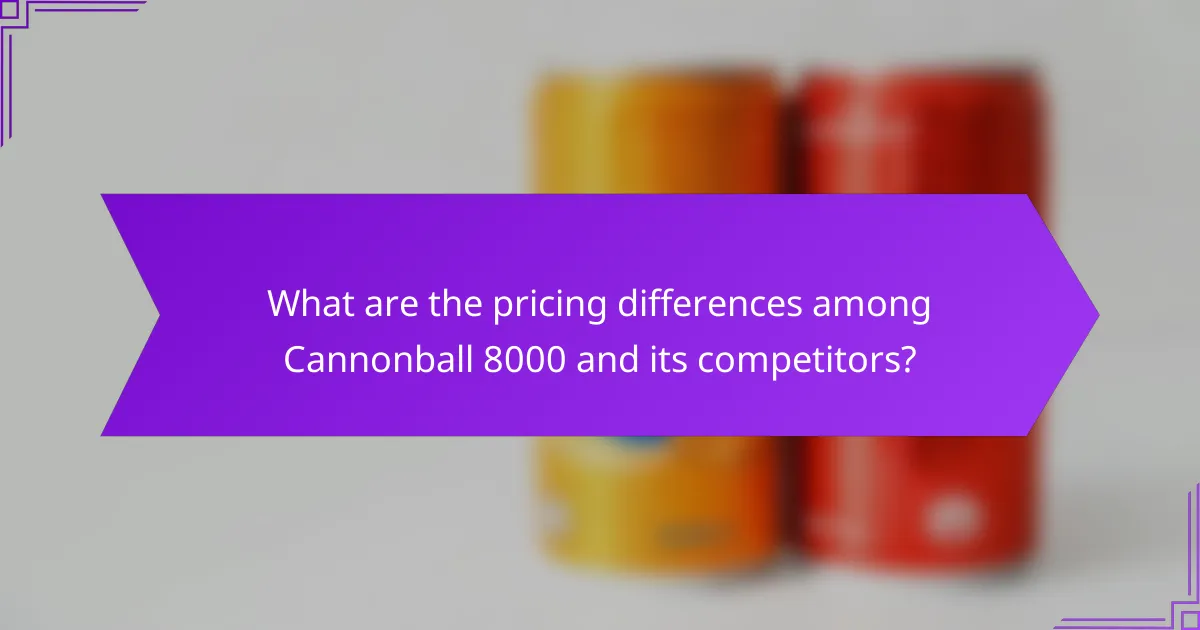
What are the pricing differences among Cannonball 8000 and its competitors?
The Cannonball 8000 generally falls within a competitive price range compared to its rivals, often offering better value for performance. Pricing can vary significantly based on features and specifications, so it’s essential to compare specific models to make an informed decision.
Base Price Comparison
The base price of the Cannonball 8000 typically starts around $1,200, while competitors may range from $1,000 to $1,500. This pricing reflects the features and performance capabilities offered by each model. When evaluating options, consider not just the initial cost but also the long-term value.
Cost of Upgrades and Accessories
Upgrades for the Cannonball 8000 can add approximately $200 to $500, depending on the enhancements chosen. Competitors may have similar or higher costs for upgrades, which can impact the overall investment. Always factor in these additional expenses when budgeting for your purchase.
Warranty and Support Costs
The Cannonball 8000 usually includes a standard warranty of one to two years, with extended support options available for an extra fee. Competitors may offer similar warranty terms, but some might charge more for extended coverage. Assess the warranty and support options as part of the total cost of ownership.
